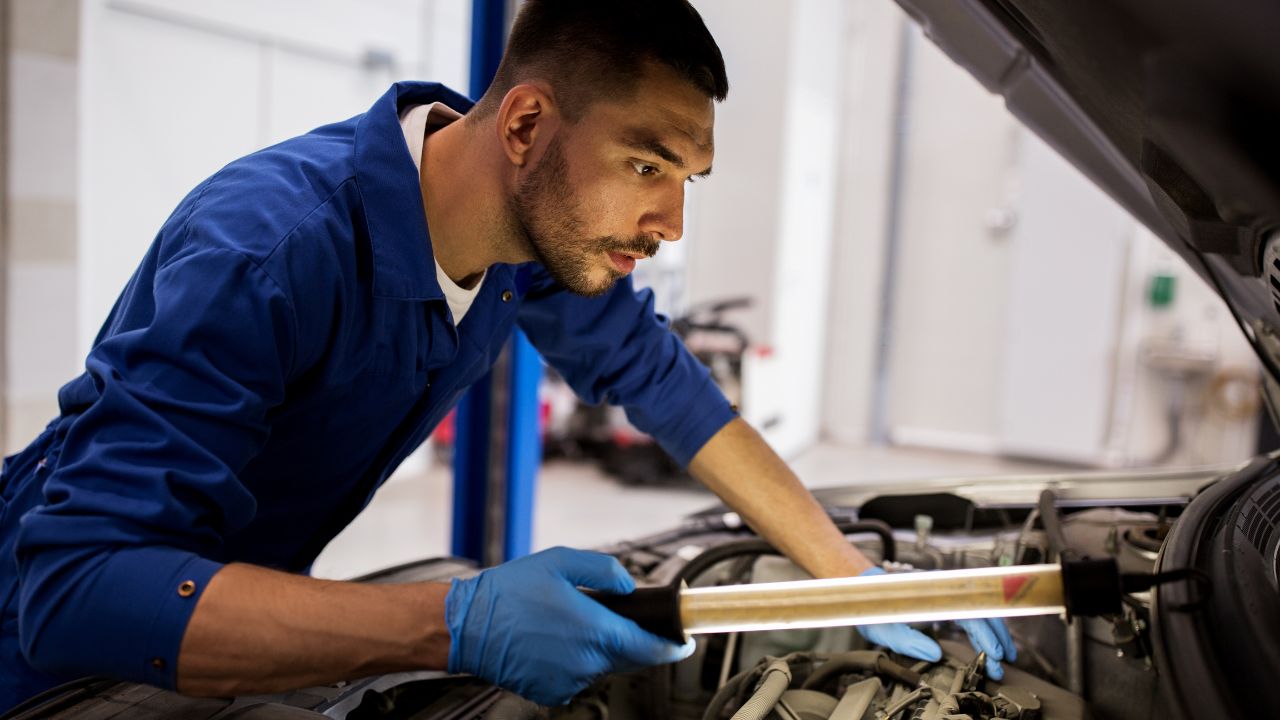
A good way to find out if your car has a leak is to take it out of its garage and look for liquids on the ground. You can determine the source and color of the liquid by placing a piece of white cardboard underneath the car. To find the most likely source, you can compare your findings to the table below. To determine the type of fluid leaking, consult your owner's guide.
A leaky car is one of the most obvious signs
You can look for signs that your car is leaking. You should check your exhaust pipe if you notice increased engine noise. Although a small leak can be minor, it could cause loud engine noise that echoes throughout your vehicle. During acceleration, the noise might get louder. An exhaust leak is most likely to be the cause of this sound. Also, a leak in an exhaust pipe could cause the emissions test to fail.
Common sources of leaks
Leakages in a vehicle are always an issue, especially if they occur during driving. Cars require various fluids to work properly. If these fluids are not checked immediately, they can leak easily. Some of the most common sources of car leaks are listed below. Antifreeze is one of the most common fluids, and it can also cause a leak in your vehicle if it freezes in the engine.
Take your car for a test drive to make sure there are no leaks
To check for a leak, you must test-drive the car. It is important to drive it in a clear, flat, long road with little traffic. You can lean the car forward, with your wheels turned sharply. Be attentive for any popping, crackling or creaking sounds coming from the car. If the noise does not stop, it could be a sign that the vehicle is having problems. If the noise persists, it is possible that there is a problem. You should inspect the front-end, motor mounts and CV joints.

Use a pressure gauge to determine if there is a leak.
A pressure tester is useful if you suspect your cooling system may be leaking. This device is a pump that pumps air into your cooling system. It simulates the coolant expanding as the engine heats. As the coolant expands, the pressure within the system rises, indicating a leak. To test the radiator, attach a tester to its top. Then pump up the gauge until it matches the cap pressure. Ideal results are a pressure increase of two to three times the normal level and a decrease of about a half inch.
FAQ
What is the length of an automotive training course?
An automotive course is three years long.
The first year of your training is devoted to theory. You will learn all about cars. Practical training is the second year. You will learn to drive, fix engines and perform other tasks around the car. The final year is spent doing a placement at a local garage, which gives you experience in fixing real-world problems.
What is the distinction between a mechanic or an automotive technician?
The two are similar but not identical. A mechanic repairs cars and an automotive technician performs maintenance.
A mechanic needs to be able and quick to use their manual dexterity. They should also be able correctly diagnose and repair any problems.
An automotive technician requires more technical skills than a mechanic. They must be able and able to read blueprints as well as use tools like drills or wrenches.
They should also be capable of safely performing complex procedures. They must also be familiarized in different types and electrical systems.
They must also be capable of understanding how parts interact.
As a result, a mechanic usually earns less money than an automotive technician. But there are many opportunities for both jobs.
Is a career in automotive mechanic promising?
For those who are passionate about excellence, automotive is a rewarding industry. It is important to work hard and learn as much from others as you can in order to succeed in this industry.
Excellent communication skills are essential as you will spend most of the time speaking to customers or other employees. You will need to be able and willing travel for work, making it more difficult to commute.
Consider taking classes at local universities or community colleges if your goal is to pursue a career in the automotive industry. Many schools offer programs for students who are interested to learn about auto sales, customer service, or repair.
If you decide to pursue a degree, you should study mechanical engineering. A bachelor's degree can be obtained in four years.
Many companies will hire students straight out of college. It's a smart idea to begin looking for work while you have the opportunity to study part-time.
After you've finished your education, it's likely that you'll need to go through some training before you can be hired as an auto technician.
This means that you must pass the Automotive Service Excellence exam. This test covers topics including engine maintenance, brakes, steering systems, suspension, and more.
After passing the ASE exam, you can apply for a National Institute for Automotive Service Excellence license.
A license allows you to perform repairs on vehicles owned by private individuals. You'll be paid based upon the number of services provided.
Not all states require licensing. However, licensing is required for anyone who plans to work outside the home state.
Some states don’t issue licenses until a certain amount has been completed. If this is you, you may need another option.
Statistics
- According to the BLS, total auto technician employment is expected to exceed 705,000 by 2030. (uti.edu)
- According to the BLS, the median annual salary for automotive service technicians and mechanics in the United States was $44,050 in May 2020. (uti.edu)
- 52% of Mechanics in the United States think their salaries are enough for the cost of living in their area. (indeed.com)
External Links
How To
How to correctly diagnose your vehicle for repairs
To determine if your car needs repairs, you should first look at the symptoms that your car presents. Follow these steps to properly diagnose your vehicle.
-
Check engine lights. Check the dashboard light indicators such as the engine light indicator, the oil pressure gauge, the battery light indicator, the coolant temperature gauge, and the RPM gauge. If they have been flashing for more days than usual, it could be a sign that something is wrong with the vehicle.
-
Take a look at the treads. Tires with worn treads could cause problems when handling or braking. You should also inspect the wheel treads. You should ensure that they are clean and smooth. You can do this by taking off the wheels. A flashlight can be used to check how worn the treads are.
-
Pay attention to the level of your brake fluid. You must always monitor the level of your brake fluid. This ensures that your brakes work properly. If your brake fluid level is low they might not work properly when you apply pressure.
-
Test the suspension system. A suspension system is designed to absorb vibrations and shocks. It improves control and allows for smoother accelerations or decelerations. Your vehicle might feel wobbly, or shake uncontrollably if it has a bad suspension. To test whether your vehicle has a suspension issue, try putting weight on the front or rear axle and observe the movement.
-
Take a look at the steering column. The steering columns are what connect the steering knob to the rest. Steering columns can be damaged by accidents. It is recommended to replace any steering column that feels loose, or shakey.
-
The exhaust pipe should be observed. The exhaust pipes are responsible for moving gases from the combustion chamber into the atmosphere. If the exhaust pipe is damaged or leaks, harmful fumes can enter your cabin. You should also fix any bent tailpipes immediately.
-
Look under the hood. Look underneath your hood to see if anything looks strange. Fluids could be leaking from your engine. If you smell something strange coming from your engine compartment you should call a professional technician.
-
The air filter should be checked. The outside environment collects dust and other particles in the vehicle's filter. Your vehicle will run less well if it has a dirty filter. Replace your air filter regularly.
-
Make sure you check the fan belt. Your vehicle's fanbel is what connects the engine and the transmission. If it breaks, the engine won't turn over. It is easy to replace the belt. All you need to replace the belt is a screwdriver with pliers.
-
Check the radiator hose and hoses. The radiator hose transports water from radiator to engine. It can cause hot liquid to leak onto the engine if it is damaged or cracked. To repair the hose, you will only need to use a pair needle-nosepliers and a wire brush.
-
Make sure you have the windshield wipers checked. Windshield wipers work by using electricity to remove rain and snow. If they stop functioning, they can leave streaks in your window glass. The solution is to change the washer fluid.
-
Check the battery cables. The battery cables supply power to your car's electrical systems. If you are replacing batteries, disconnect the negative cord first. Failure to do so can damage your alternator.
-
Pay attention to your headlights. Headlights illuminate the road ahead of you. If they don't work properly, it can cause poor visibility. To determine if your bulbs are out of date, check them.
-
Make sure you have your lights on. The lights are there to warn other drivers if they approach you at night. You may be distracted by the light and end up in an accident.
-
Inspect your brakes. Before you have a collision, brakes slow down your car. If the brakes fail to work correctly, your car could lose control and collide with another vehicle.
-
Make sure to change the oil. The oilkeeps your engine lubricated. It prevents metal parts from rusting too quickly. It is recommended that you change your oil at least once per month.